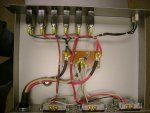Re: Another power distro thread
This practice is specifically not allowed in Ontario as per document ESA SPEC-003.
4.16 Any single phase power supply shall have its load connectors connected:
a) bond to bond direct connection only; and, b) neutral to neutral direct connection only; and, c) phase to line (Phase A to Line 1, Phase B to Line 2), direct connection only; and, d) any remaining Phase “C” or third line from the load that cannot be supplied directly
from a dedicated power supply line without resort to a Tee fitting or similar device shall be capped off and remain unconnected and unenergized.
A warning label shall be provided as follows:
“WARNING” Phase “C” is not connected and not energized. Single phase source supplies only Phase “A” and “B” of three phase system.
This document is very handy.
http://eesco.ca/wp-content/uploads/2010/12/ESA-SPEC-003-R6.pdf
I have done lots of gigs with 3 phase distros when only single phase power was available. You use a T tap to join two legs and carry on.
This practice is specifically not allowed in Ontario as per document ESA SPEC-003.
4.16 Any single phase power supply shall have its load connectors connected:
a) bond to bond direct connection only; and, b) neutral to neutral direct connection only; and, c) phase to line (Phase A to Line 1, Phase B to Line 2), direct connection only; and, d) any remaining Phase “C” or third line from the load that cannot be supplied directly
from a dedicated power supply line without resort to a Tee fitting or similar device shall be capped off and remain unconnected and unenergized.
A warning label shall be provided as follows:
“WARNING” Phase “C” is not connected and not energized. Single phase source supplies only Phase “A” and “B” of three phase system.
This document is very handy.
http://eesco.ca/wp-content/uploads/2010/12/ESA-SPEC-003-R6.pdf

